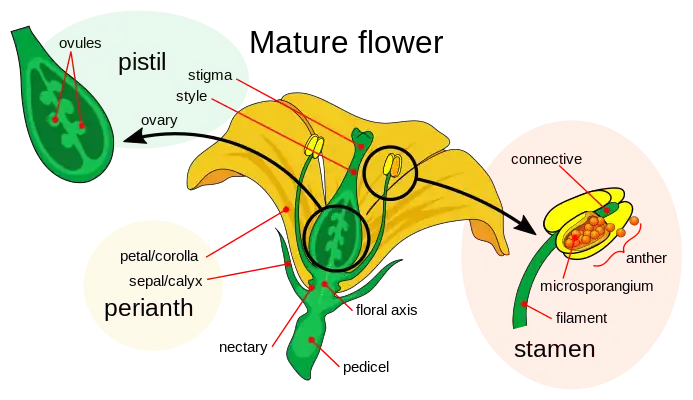The floral axis (sometimes referred to as the receptacle) is the area of the flower upon which the reproductive organs and other ancillary organs are attached. It is also the point at the center of a floral diagram. Many flowers in division Angiosperma appear on floral axes. The floral axis can differ in form depending on the type of plant. For example, monocotyledons have a weakly developed floral axis compared to dicotyledons, and will therefore rarely possess a floral disc, which is common among dicotyledons.[1]
Floral diagramming

Floral diagramming is a method used to graphically describe a flower. In the context of floral diagramming, the floral axis represents the center point around which the diagram is oriented.[3] The floral axis can also be referred to as the receptacle in floral diagrams or when describing the structure of the flower.[4] The main or mother axis in floral diagrams is not synonymous with the floral axis, rather it refers to where the stem of the flower is in relation to the diagram. The floral axis is also useful for identifying the type of symmetry that a flower exhibits.[5]
Function
The floral axis serves as the attachment point for organs of the flower, such as the reproductive organs (pistil and stamen) and other organs such as the sepals and carpels.[6] The floral axis acts much like a modified stem and births the organs that are attached to it.[7] The fusion of a plant's organs and the amount of organs that are developed from the floral axis largely depends on the determinateness of the floral axis.[8] The floral axis does perform different functions for different types of plants. For instance, with dicotyledons, the floral axis acts as a nectary, while that is not the case with monocotyledons.[1] More specialized functions can also be performed by the floral axis. For example, in the plant Hibiscus, the floral axis is able to proliferate and produce fruit, rendering processes like self pollination unnecessary.[9]

References
- 1 2 Dahlgren, R.M.T; Clifford, H.T; Yeo, P.F (1985). The Families of the Monocotyledons - Structure, Evolution, and Taxonomy | R.M.T. Dahlgren | Springer. ISBN 9783540136552.
- ↑ "Floral diagrams and formulae • Floral diagram generator". herba.msu.ru. Retrieved 2018-04-11.
- ↑ Prenner, Gerhard; Bateman, Richard M.; Rudall, Paula J. (2010). "Floral Formulae Updated for Routine Inclusion in Formal Taxonomic Descriptions". Taxon. 59 (1): 241–250. JSTOR 27757066.
- ↑ Kaplan, Donald R. (1967-11-01). "FLORAL MORPHOLOGY, ORGANOGENESIS AND INTERPRETATION OF THE INFERIOR OVARY IN DOWNINGIA BACIGALUPII". American Journal of Botany. 54 (10): 1274–1290. doi:10.1002/j.1537-2197.1967.tb10765.x. ISSN 1537-2197.
- ↑ Jesson LK, Barrett SC (September 2002). "The genetics of mirror-image flowers". Proceedings: Biological Sciences. 269 (1502): 1835–9. doi:10.1098/rspb.2002.2068. PMC 1691103. PMID 12350272.
- ↑ "Floral axis | plant anatomy". Encyclopedia Britannica. Retrieved 2018-04-11.
- ↑ McCoy, Ralph W. (1940-10-01). "FLORAL ORGANOGENESIS IN FRASERA CAROLINENSIS". American Journal of Botany. 27 (8): 600–609. doi:10.1002/j.1537-2197.1940.tb10921.x. ISSN 1537-2197.
- ↑ Schaffner, John H. (1937). "The Fundamental Nature of the Flower". Bulletin of the Torrey Botanical Club. 64 (9): 569–582. doi:10.2307/2481128. JSTOR 2481128.
- ↑ Bergman, H. F. (1932-07-01). "INTRACARPELLARY FRUITS AND OTHER CENTRAL PROLIFERATIONS OF THE FLORAL AXIS IN HIBISCUS". American Journal of Botany. 19 (7): 600–603. doi:10.1002/j.1537-2197.1932.tb08845.x. ISSN 1537-2197.